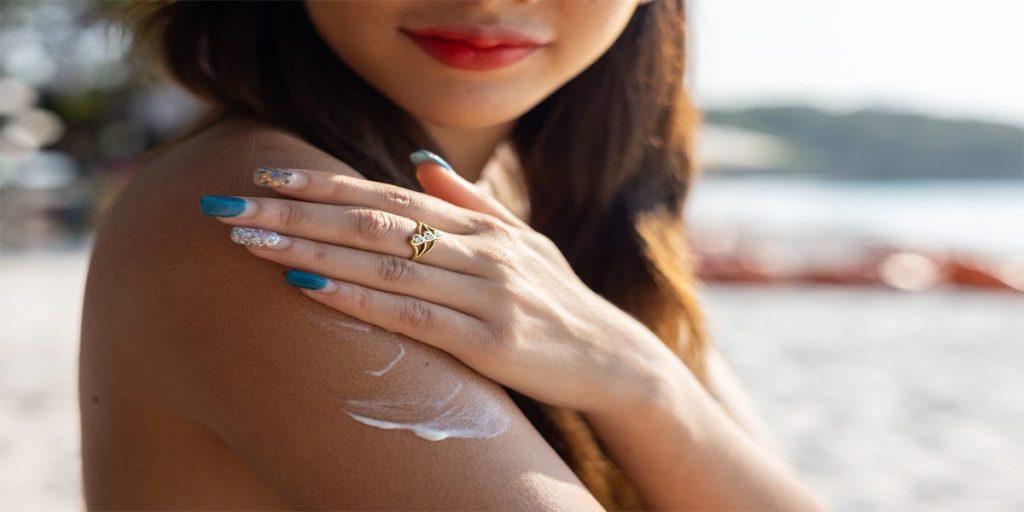When you buy through our links, Insider may earn an affiliate commission. Learn more.
- Sunscreen can block most of the sun's rays and protect your skin from cancer-causing UV damage.
- Sunlight prompts your body to make skin-darkening melanin, so you may still tan with sunscreen.
- Sunless tanning products with nourishing ingredients can highlight your glow and help hydrate skin.
While sunscreen might make it harder to get that coveted summer glow, it doesn't entirely prevent tanning.
More importantly, though, sunscreen makes it safer to get outside and enjoy the sunshine without increasing your risk for skin cancer and prematurely aged skin.
Here's what you should know about sunscreen and tanning.
How does sunscreen work?
When exposed to sunlight, your skin tries — emphasis on "tries" — to shield itself from the sun's UV radiation by producing melanin, which darkens your skin tone and creates a tan.
Since sunscreen blocks UV rays, your body doesn't need to make as much melanin to protect itself, so your skin doesn't turn as dark as it would without sunscreen.
Different types of sunscreen protect you from tanning in different ways:
- Physical or mineral sunscreen creates a physical barrier to reflect the sun's rays away from your body. These sunscreens are zinc or titanium oxide-based and work great on sensitive skin, but they often leave a white cast.
- Chemical sunscreen contains chemical filters, such as octisalate and oxybenzone, which absorb radiation instead of reflecting it. These sunscreens are less likely to leave a white cast, but oxybenzone can negatively affect coral reefs and other marine life.
As you may have noticed, however, you can still tan when wearing sunscreen. That's because the SPF rating on your sunscreen only takes UVB rays into account.
Sunscreen does a good job of protecting you from UVB rays that burn your skin, but you may not be protected from dangerous UVA rays that cause tanning unless you choose a broad-spectrum sunscreen. So, you might still produce a little extra melanin for a subtle tan.
Risks of not wearing sunscreen
You won't tan as much with sunscreen on because fewer rays will reach you, but you'll be much safer.
UV radiation causes skin cancers like melanoma, basal cell carcinoma, and squamous cell carcinoma, which can be fatal if left untreated.
Skin cancer affects one in five people in the US, with rates rising yearly.
But skipping sunscreen is a bad idea for a handful of other reasons, too:
- Sunburns
- Skin blisters
- Premature aging and wrinkles
- Liver or age spots
Can you tan safely?
"There's no safe way to tan. The tanning process is UV damage masquerading as what many people think is 'healthy-looking' skin," says Dr. Joseph Greco, a dermatologist in private practice.
Experts agree getting a UV-based tan without upping your risk of skin cancer is impossible. Case in point: 9 in 10 melanomas come from sunlight, sunlamps, and tanning beds. Just one trip to the tanning bed before age 35 increases your risk of melanoma by 75%.
In search of a safe tan? Your best bet involves UV-free spray tans from a salon or home sunless tanning.
Safer self-tanning options include:
- Mousse
- Foam
- Spray
- Lotion
- Wipes
- Moisturizer
- Face mist
- Serum
As an added bonus, self-tanners often include perks like hyaluronic acid, coconut oil, and silk amino acids to keep your skin dewy and glowing.
Lying out in the sun, on the other hand, can dehydrate you and your skin.
What to do if you don't want to tan
Maybe you're actively trying to avoid tanning. If so, sunscreen is only part of the picture.
You'll also want to stay inside or seek shade during the sun's peak hours.
"While the sun is directly above you and the UV rays are most damaging, you'll notice that you cast a small and short shadow. Remember the 4 S's: If your Shadow is Shorter than you, Seek Shade," Greco says.
You can reduce your chances of tanning by:
- Wearing sunscreen.
- Layering makeup containing SPF on top of your sunscreen.
- Steering clear of reflective materials that increase your risk of sunburn, such as water, sand, and snow.
- Covering your skin with clothes made with tightly-woven materials, long-sleeved shirts, hats, and sunglasses.
- Finding a shaded area under a tree, overhang, or beach umbrella.
Make sure, too, that your sunscreen hasn't expired, and that you follow the label instructions to store it properly. Sunscreen has a shelf life of only 3 years, but that timeframe shortens if you expose it to high temperatures by leaving it outside or in a hot car.
Insider's takeaway
While sunscreen does limit your tanning ability, you may still get a light tan from the mild rays that filter through your sunscreen. Self-tanners and salon spray tans can help you achieve a more noticeable look.
That said, experts agree you should skip the all-natural approach to tanning to protect yourself from blisters, burns, and skin cancer. If you want to prevent tanning altogether, wearing broad-spectrum sunscreen daily and covering up when you go outside can help.
